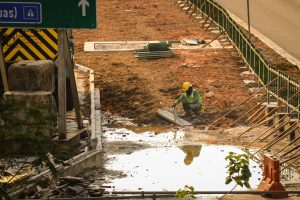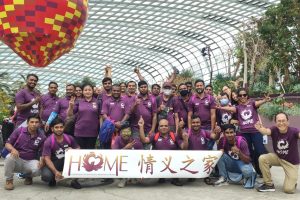Lack of Masks, Sanitiser
Disappointingly, migrant workers have been excluded from free provisions of sanitiser, and with the exception of domestic helpers, have also been excluded from the provision of free reusable masks. This comes at a time when migrant workers are already extremely worried for their health and safety, and unable to purchase masks for themselves due to their meagre salaries.
Some members of the migrant community have taken the situation into their own hands by independently asking for mask and sanitiser donations and distributing them to the migrant community. Earlier in February, Zakir, a Bangladeshi migrant worker, had partnered with a few community organizations to distribute more than 4,000 face masks, 3,000 bottles of hand sanitiser and 2,500 soap bars.

As the crisis rapidly evolves, some migrant workers are also increasingly pessimistic about the efficacy of masks or sanitiser in curbing the situation, arguing that the dorms represent a greater public health threat. As many have pointed out, the physical conditions of the dormitories themselves—tightly packed quarters that house thousands of migrant workers—make social distancing nearly impossible to achieve.
Said Zakir, “Inside one room, twelve, maybe twenty people live together. They don’t have much ventilation. How can we practice social distancing?” Indeed, according to Zakir, the lack of ventilation has resulted in workers sleeping in the canteen or other available open spaces. He added, “They use the kitchen, toilet, everything together—don’t have scope to make social distancing work.”
To address this, Zakir suggested that the government build dormitories for social distancing purposes, while NGOs like TWC2 have called for existing spaces like army barracks or community centers into temporary housing to help de-densify existing dormitories until the pandemic is over.
Beyond the dormitories, the very transportation that migrant workers use also represents a public health threat. Said Madhavan, an Indian migrant construction worker, “We cannot maintain 1m distance everywhere—the migrant transport, the lorries, maybe 13-15 people all sit together. Big lorry, maybe got 40 people.”
With new updates and guidelines every day, migrant workers also struggle to keep track of the information flood, especially in an unfamiliar language.
While organizations like the Migrant Workers’ Center (MWC) have been trying to communicate social distancing measures and translate government advisories for workers, the rapid development of new cases has strained translation efforts. As such, information dissemination amongst dormitories is unequal and limited, and some migrant workers have had to rely on news outlets from their home countries to keep abreast of information in Singapore. This has contributed to the spread of misinformation amongst the community—for instance, there were rumours circulating about a worker who had purportedly died from Covid-19, though nothing of that sort had happened.
Without reliable and accessible information, some migrant communities have stepped up to fill these perceived gaps. Migrant workers like Omar Faroque Shipon have taken it upon themselves to provide regular updates of the Covid-19 situation in Singapore for the substantial Bengali-speaking community, translating important information and providing live updates through this Facebook page which is followed by more than 30,000 people.
Shipon was inspired to start this after seeing “many people spread rumors through social media.” He added, “I thought I needed to do something, so I started translating updates from Singapore’s Ministry of Manpower and Ministry of Health into Bengali. Many of the migrant workers’ families back in Bangladesh also started following the page, and thanked me via messenger.”
Said Rocky, a Bangladeshi migrant worker who follows the page, “This is important because not everyone is equally informed about what is going on. Some people still come to ask me, what are the precaution measures we can take?”
In this pandemic, information flow is crucial to curb unnecessary panic, as well as to educate migrant workers on how to practice proper hygiene to make up for the squalid conditions in dormitories. Indeed, Zakir observed how, during his earlier distribution of hand sanitiser, some migrant workers had rejected it, saying, “I don’t want this one—this one do what? I don’t know,” opting for soap instead.
Zakir explained, “You have to educate people how to use them—most of migrant workers come from the Third World, they don’t use these kinds of things.”
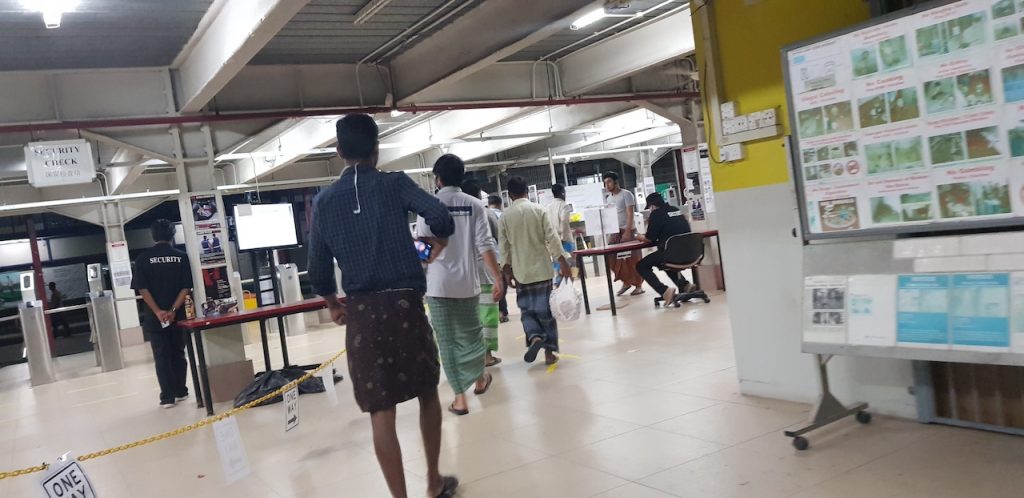
While some dormitories had put in place stringent temperature taking measures at the start of the pandemic, it appears some dormitories have quietly abandoned these practices due to the long queues that inevitably form before and after work hours. Further, while there is still yellow tape on the ground for social distancing purposes, there is a lack of enforcement on whether these measures are actually observed.
Said Rocky, “I never see social distancing, from the beginning to now—people never comply. I just see the entrance got temperature scanning, but no people monitor, no control measures, nothing.”
As more migrant workers have tested positive, other dormitories have stepped up efforts to contain the crisis through increased health checks. According to Madhavan, police officers will be coming into the dormitories to conduct temperature checks for everyone from today evening, and anyone with a fever will be sent to the hospital immediately. While this might be a sign that dormitories are taking precautions more seriously, greater police involvement might also create unnecessary stress and panic amongst a population already wary of enforcement.
Uncertain Salaries, Uncertain Futures
Beyond health, migrant workers also remain uncertain about the financial implications of a “circuit breaker” announced by PM Lee last Friday, for the physical nature of their jobs makes working from home impossible. Most companies have already issued advisories to their workers informing them of a one-month work from home policy—for most migrant workers, this simply means waiting in their dormitories, until the one month ends.
Madhavan says nothing has been communicated about salaries so far: “All the workers waiting for official information”. When his fellow workers clarified with their companies, they were told to wait till Monday, where Minister Heng is expected to make a speech about government provisions to support construction companies during this period.
For the moment, it seems like each company is adopting its own policy. At Zakir’s company, migrant workers have been asked to take a 5% pay cut. “My company is kind,” Zakir says, “but others have not been so lucky.” Some of his friends have had to accept 50% wage cuts, while others have had to forfeit their salaries altogether.
Migrant workers, as non-citizens, are not currently entitled to the Budget benefits announced by the government. For instance, the Enhanced Jobs Support Scheme, which covers up to 75% of employees’ salaries up to a cap of $4,600, only applies to local workers. It is unclear if the Ministry of Manpower would issue further guidelines on salaries for an already precarious population—many of whom already owe existing debt obligations to brokerage agents, and whose families back home depend on their monthly remittances to survive.
In today’s Solidarity Budget, Minister Heng announced that the government would waive this month’s foreign worker levy for employers, and also provide employers with a $750 rebate for each Work Permit and S-Pass holder.
However, absent of any legislation, it is not certain that firms will necessarily pass off these cost savings to migrant workers. As the earlier debacle over the property tax rebates has shown, “trickle-down economics” is nothing more than a bizarre fantasy, as tenants remain sceptical that landlords will pass on rebates to tenants. The government has since rectified this by introducing a law that would compel landlords into compliance. Similar legislation should be extended in this case to ensure that companies pass on rebates to migrant workers, and to hold companies accountable for firing workers or imposing severe pay cuts.
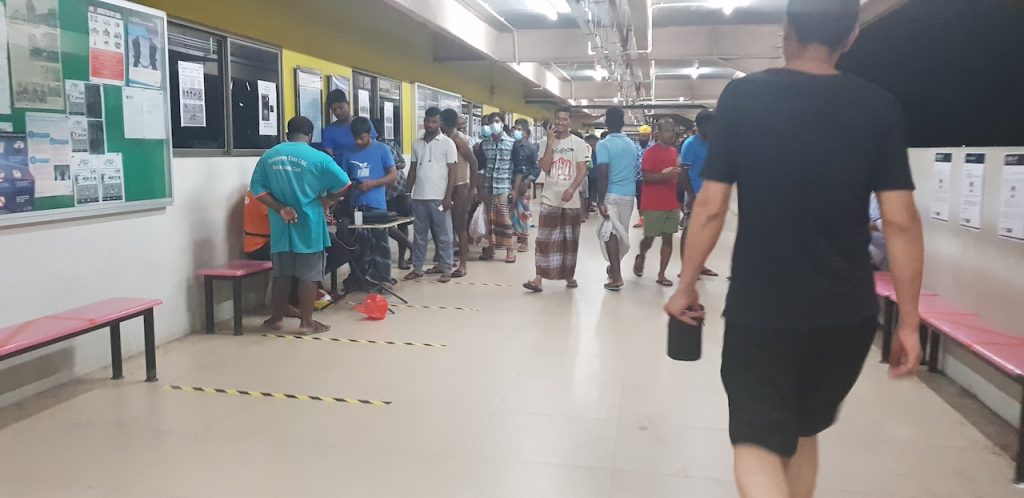
Yesterday, the government announced an official quarantine for all twenty thousand workers living in the two dormitories in Punggol and Toh Guan West Lite. Although Minister Josephine Teo said that all affected workers living in the government-gazetted dormitories for isolation will be paid wages, as their quarantine will be treated as part of their paid hospitalization fees guaranteed under workers’ statutory leave liability, it is not clear if this applies to workers living in dormitories whose companies—rather than the government—imposed lockdowns.
For these migrant workers, wages are not the only issue—many are also worried about what a “lockdown” means exactly. Said Ripon, a Bangladeshi migrant worker who lives in a dormitory in Penjuru, “from tomorrow onwards, my dorm will also be in lockdown, but I’m not sure if I can still go out to get food and other essential necessities.”
Other migrant workers like Rocky worry about what he is going to do to pass the time in a small and crowded room while in quarantine. “They don’t have Wi-Fi in the rooms, only in the corridors,” he explains, “so I’ve downloaded lots of PDF books, but I’m not sure it will last me two weeks.”
More crucially, while Minister Teo has said that they are “actively converting more spaces” to facilitate social distancing, it remains unclear how quickly and how well this can be achieved. Said Nizam, a Bangladeshi migrant worker currently living in the gazetted Punggol dormitory—“We living very crowded, we are scared, this is more dangerous.” For as Nizam explained, “one room we living is twelve people, one floor has fourteen rooms. All fourteen rooms, everyone use one common toilet—if one man have [Covid-19], everyone will be infected.”
These fears are exacerbated by the fact that dormitories have not seemed to step up hygiene practices, despite being gazetted by the government as official isolation areas. According to a migrant worker interviewed by the Straits Times, “You can see cockroaches crawling in the rooms. There are also many mosquitoes. Many people just stood outside their rooms, in the corridors. There are also smoking areas at each end of the corridors, and the toilets are also there. You can smell urine when you stand outside the rooms.”
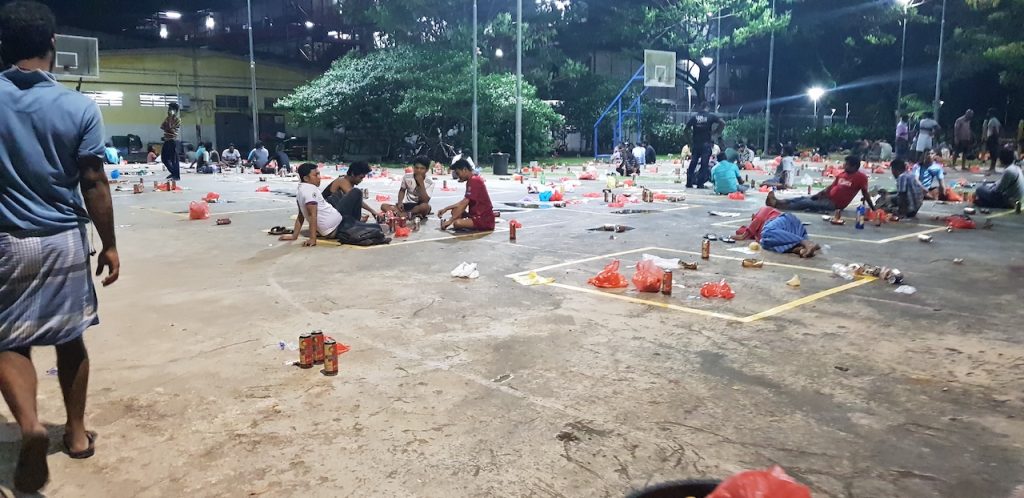
The pandemic has taken a significant mental toll on migrant workers, who fret about their uncertain futures against this climate of fear. Said Rocky, “I am very worried and very stressed, because I don’t know what’s going on.” Their families back home fret for them too—“My family in Bangladesh is worried about me,” says Zakir.
“They call me every day to ask me how I’m doing.”
The psychological toll for migrant workers living in the affected dormitories is also substantial. Said Nizam, “Some people are panicked, because everyday we see people being taken out—we see in front of our eyes. Every morning, every evening, got ambulance come and take people. It’s very scary.” Yet, there remains no mental health resources available for migrant workers during this trying period—a disappointing, but perhaps unsurprising fact considering how this was already status quo prior to the crisis.
Many of these migrant workers are simply existing in a state of limbo, awaiting further information. It remains to be seen if the Ministry of Manpower and Ministry of Health would issue further advisories regarding public health provisions and workers’ salaries, and whether the much-anticipated speech by Minister Heng would indeed address all of these pressing concerns.
Regardless, it is extremely concerning that the government is only now rolling out these reactionary measures, when more could have been done earlier to contain the public health crisis. In a scathing Facebook post today, Prof. Tommy Koh echoed the sentiments of many NGOs when he wrote, “the dormitories were like a time bomb waiting to explode.” Back in early March, doctors from HealthServe were already warning about the lack of provisions for the migrant community, arguing that migrant workers represent “the weakest link” in our public health chain—a sentiment that other articles have similarly pointed out.
To be clear, we should not view these measures as important only insofar as they threaten locals’ health. As fellow human beings—and as a group that has contributed to and sacrificed so much for Singapore—it is only right that we take our responsibilities to keep migrant workers and their families safe seriously.
Further, many of these issues—poor living conditions, public health inequities—were issues long before the Covid-19 crisis emerged. Post-crisis, we need systemic and permanent change rather than a temporary knee-jerk one that only deals with the immediate pandemic.
Still, not all is lost. The government can still commit to measures that can assuage the current situation, even if it cannot turn back the clock. Each of the issues raised here can be addressed with specific measures that will go a long way in both curbing the public health threat and in improving the quality of lives of affected migrant workers.
For one, there is an urgent need to de-densify the dormitories to make social distancing a workable—rather than laughable—reality. For another, the measures provided for those under official quarantine should be extended to all migrant workers: the provision of free masks and thermometers, the reassurance about wages, the provision of essential food and services, as well as on-site medical care. There are other seemingly trivial, but actually material measures that can be introduced: ensuring that migrant workers have accessible and up-to-date information in their native languages, providing mental health resources, and providing free Wifi in dormitories.
These measures cannot excuse the government from its earlier oversights, but they can be how it makes amends. The best time to enact these measures was yesterday. The next best time is now.


